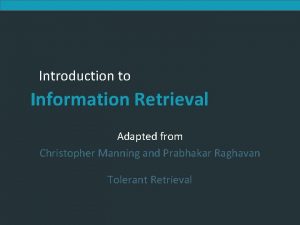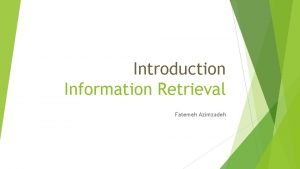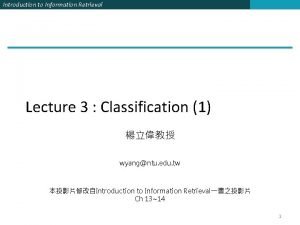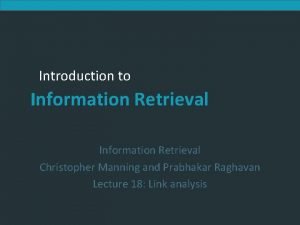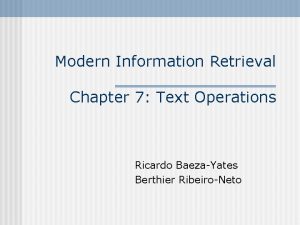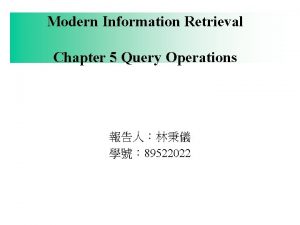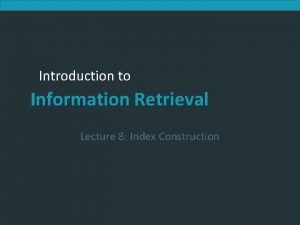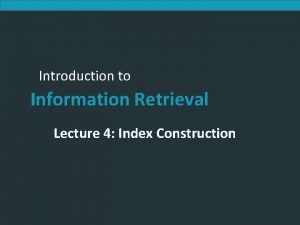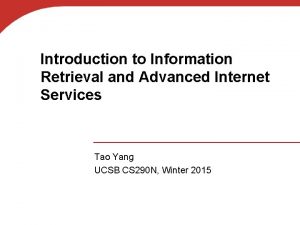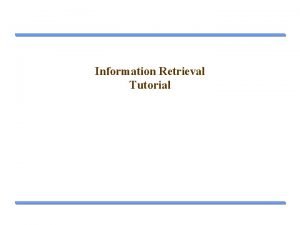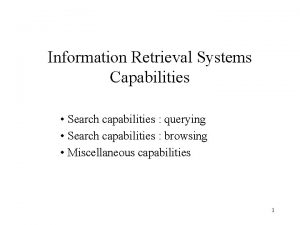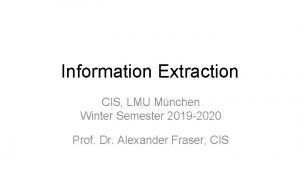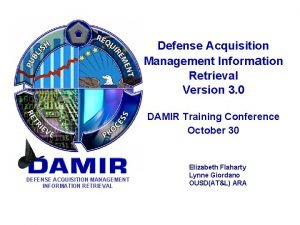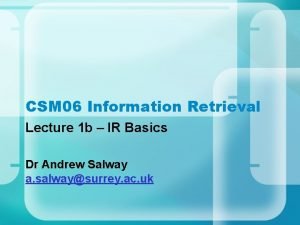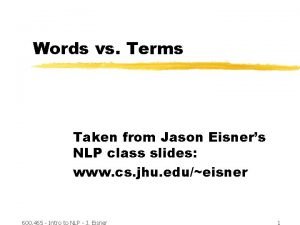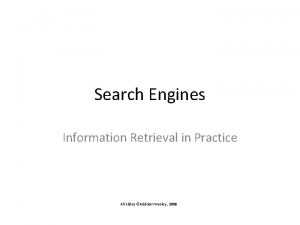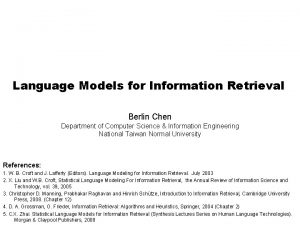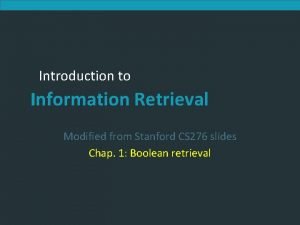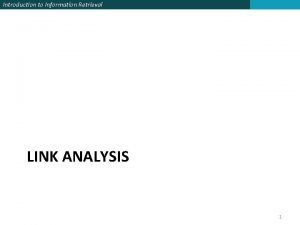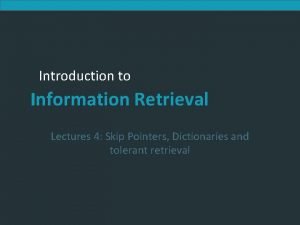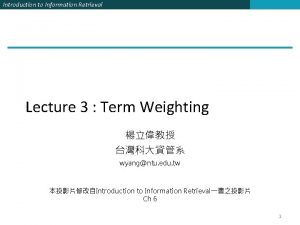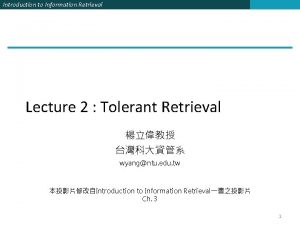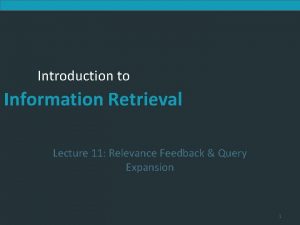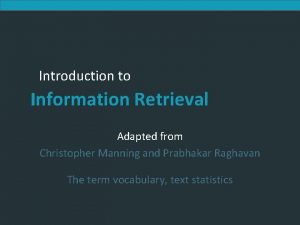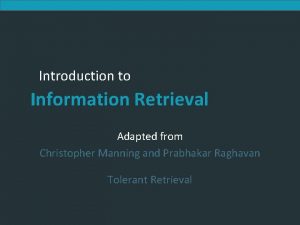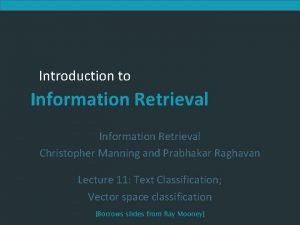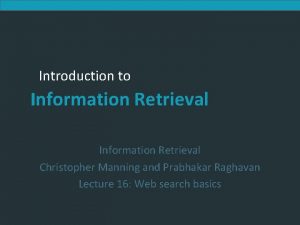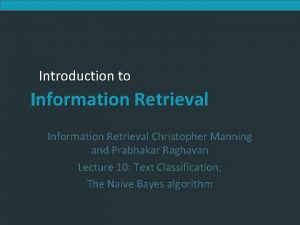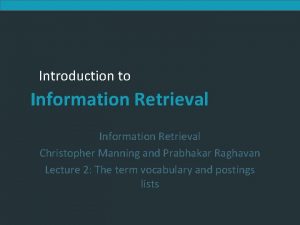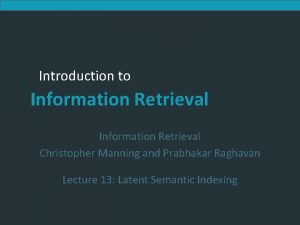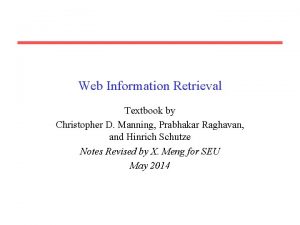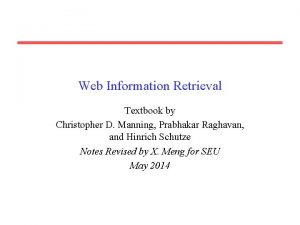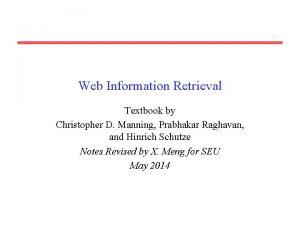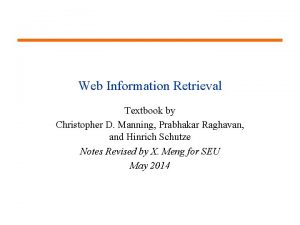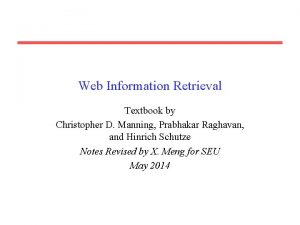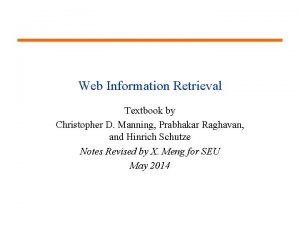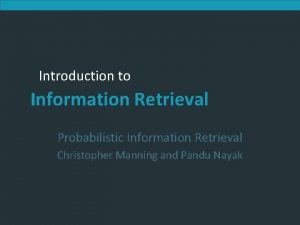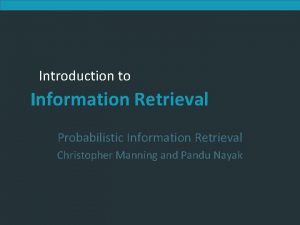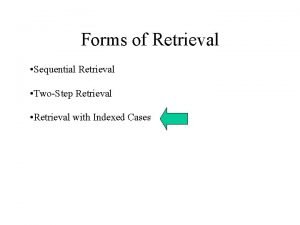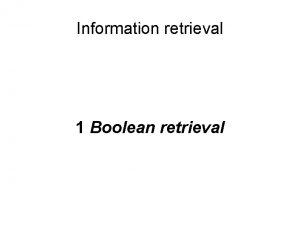Introduction to Information Retrieval Adapted from Christopher Manning































- Slides: 31

Introduction to Information Retrieval Adapted from Christopher Manning and Prabhakar Raghavan Tolerant Retrieval

Introduction to Information Retrieval Sec. 3. 2 Wild-card queries: * § mon*: find all docs containing words beginning with “mon”. § Use a Prefix-search data structure § *mon: find words ending in “mon” § Maintain an additional data structure for terms backwards. Exercise: from this, how can we enumerate all terms meeting the wild-card query pro*cent ?

Introduction to Information Retrieval Sec. 3. 2 What about * in the middle? § co*tion § We could look up co* AND *tion and intersect the two lists § Expensive § se*ate AND fil*er This may result in many Boolean AND queries. § The solution: transform wild-card queries so that the *’s occur at the end § This gives rise to the Permuterm Index.

Introduction to Information Retrieval Permuterm index § For term hello, index under: § hello$, ello$h, llo$he, lo$hel, o$hell where $ is a special symbol. § Queries: § § § X lookup on X$ X* lookup on $X* *X lookup on X$* *X* lookup on X* X*Y lookup on Y$X* X*Y*Z ? ? ? Exercise! Sec. 3. 2. 1

Introduction to Information Retrieval Sec. 3. 2. 1 Permuterm query processing § Rotate query wild-card to the right § P*Q Q$P* § Now use prefix-search data structure § Permuterm problem: ≈ quadruples lexicon size Empirical observation for English.

Introduction to Information Retrieval Sec. 3. 2. 2 Bigram index example § The k-gram index finds terms based on a query consisting of k-grams (here k=2). $m mace madden mo among amortize on among around

Introduction to Information Retrieval Sec. 3. 2. 2 Processing wild-cards § Query mon* can now be run as § $m AND mo AND on § Gets terms that match AND version of our wildcard query. § But we’d enumerate moon. § Must post-filter these terms against query. § Fast, space efficient (compared to permuterm).

Introduction to Information Retrieval SPELLING CORRECTION

Introduction to Information Retrieval Spell correction § Two principal uses § Correcting document(s) being indexed § Correcting user queries to retrieve “right” answers § Two main flavors: § Isolated word § Check each word on its own for misspelling § Will not catch typos resulting in correctly spelled words § e. g. , from form § Context-sensitive § Look at surrounding words, § e. g. , I flew form Heathrow to Narita. Sec. 3. 3

Introduction to Information Retrieval Sec. 3. 3 Document correction § Especially needed for OCR’ed documents § Correction algorithms are tuned for this: rn/m § Can use domain-specific knowledge § E. g. , OCR can confuse O and D more often than it would confuse O and I (adjacent on the QWERTY keyboard, so more likely interchanged in typing). § web pages and even printed material has typos § Goal: the dictionary contains fewer misspellings

Introduction to Information Retrieval Sec. 3. 3 Query mis-spellings § Our principal focus here § E. g. , the query Alanis Morisett § We can either § Retrieve documents indexed by the correct spelling, OR § Return several suggested alternative queries with the correct spelling § Did you mean … ?

Introduction to Information Retrieval Sec. 3. 3. 2 Isolated word correction § Fundamental premise – there is a lexicon from which the correct spellings come § Two basic choices for this § A standard lexicon such as § Webster’s English Dictionary § An “industry-specific” lexicon – hand-maintained § The lexicon of the indexed corpus § E. g. , all words on the web § All names, acronyms etc. § (Including the mis-spellings)

Introduction to Information Retrieval Sec. 3. 3. 2 Isolated word correction § Given a lexicon and a character sequence Q, return the words in the lexicon closest to Q § What’s “closest”? § Edit distance (Levenshtein distance) § Weighted edit distance § n-gram overlap

Introduction to Information Retrieval Sec. 3. 3. 3 Edit distance § Given two strings S 1 and S 2, the minimum number of operations to convert one to the other § Operations are typically character-level § Insert, Delete, Replace, (Transposition) § E. g. , the edit distance from dof to dog is 1 § From cat to act is 2 (Just 1 with transpose. ) § from cat to dog is 3. § Generally found by dynamic programming.

Introduction to Information Retrieval Sec. 3. 3. 3 Weighted edit distance § As above, but the weight of an operation depends on the character(s) involved § Meant to capture OCR or keyboard errors, e. g. m more likely to be mis-typed as n than as q § Therefore, replacing m by n is a smaller edit distance than by q § Requires weight matrix as input § Modify dynamic programming to handle weights

Introduction to Information Retrieval Sec. 3. 3. 4 Using edit distances § Given query, first enumerate all character sequences within a preset (weighted) edit distance (e. g. , 2) § Intersect this set with list of “correct” words § Show terms you found to user as suggestions § Alternatively, § Compute edit distance against all dictionary words … slow

Introduction to Information Retrieval Approximate String Matching § Solved by dynamic programming § Let E(i, j) = edit distance between T 1, j and P 1, i. E(i, 0)=E(0, i)=i E(i, j) = E(i– 1, j– 1) if Pi=Tj E(i, j) = min{E(i, j– 1), E(i– 1, j– 1)}+1 if Pi Tj

Introduction to Information Retrieval Example T 0 0 1 P 2 3 4 p a t t 0 1 2 3 4 5 6 p t t a p a 1 0 1 2 3 2 1 1 1 2 3 2 2 1 1 4 3 2 2 2 5 4 3 3 3 6 5 4 4 4 3 -18

Introduction to Information Retrieval Sec. 3. 3. 4 n-gram overlap § Enumerate all the n-grams in the query string as well as in the lexicon § Use the n-gram index (recall wild-card search) to retrieve all lexicon terms matching any of the query n -grams § Threshold by number of matching n-grams § Variants – weight by keyboard layout, etc.

Introduction to Information Retrieval Sec. 3. 3. 4 Example with trigrams § Suppose the text is november § Trigrams are nov, ove, vem, emb, mbe, ber. § The query is december § Trigrams are dec, ece, cem, emb, mbe, ber. § So 3 trigrams overlap (of 6 in each term) § How can we turn this into a normalized measure of overlap?

Introduction to Information Retrieval Sec. 3. 3. 4 One option – Jaccard coefficient § Let X and Y be two sets; then the J. C. is § Equals 1 when X and Y have the same elements and zero when they are disjoint § X and Y don’t have to be of the same size § Always assigns a number between 0 and 1 § Now threshold to decide if you have a match § E. g. , if J. C. > 0. 8, declare a match

Introduction to Information Retrieval Sec. 3. 3. 4 Matching trigrams § Consider the query lord – we wish to identify words matching 2 of its 3 bigrams (lo, or, rd) lo alone lord sloth or border lord morbid rd ardent border card lord Standard postings “merge” will enumerate …

Introduction to Information Retrieval Sec. 3. 3. 5 Context-sensitive spell correction § Text: I flew from Heathrow to Narita. § Consider the phrase query “flew form Heathrow” § We’d like to respond Did you mean “flew from Heathrow”? because no docs matched the query phrase.

Introduction to Information Retrieval Sec. 3. 3. 5 Context-sensitive correction § Retrieve dictionary terms close (in weighted edit distance) to each query term § Try all possible resulting phrases with one word “fixed” at a time § flew from heathrow § fled form heathrow § flea form heathrow § Hit-based spelling correction: Suggest the alternative that has lots of hits.

Introduction to Information Retrieval SOUNDEX

Introduction to Information Retrieval Sec. 3. 4 Soundex § Class of heuristics to expand a query into phonetic equivalents § Language specific – mainly for names § E. g. , chebyshev tchebycheff § Invented for the U. S. census … in 1918

Introduction to Information Retrieval Sec. 3. 4 Soundex – typical algorithm § Turn every token to be indexed into a 4 -character reduced form § Do the same with query terms § Build and search an index on the reduced forms § (when the query calls for a soundex match)

Introduction to Information Retrieval Sec. 3. 4 Soundex – typical algorithm 1. Retain the first letter of the word. 2. Change all occurrences of the following letters to '0' (zero): 'A', E', 'I', 'O', 'U', 'H', 'W', 'Y'. 3. Change letters to digits as follows: § B, F, P, V 1 § C, G, J, K, Q, S, X, Z 2 § D, T 3 § L 4 § M, N 5 § R 6

Introduction to Information Retrieval Sec. 3. 4 Soundex continued 4. Remove all pairs of equal digits with one of them. 5. Remove all zeros from the resulting string. 6. Pad the resulting string with trailing zeros and return the first four positions, which will be of the form <uppercase letter> <digit>. E. g. , Herman becomes H 06505 H 655.

Introduction to Information Retrieval Sec. 3. 4 Soundex § Soundex is the classic algorithm, provided by most databases (Oracle, Microsoft, …) § How useful is soundex? § Not very – for information retrieval § Okay for “high recall” tasks (e. g. , Interpol), though biased to names of certain nationalities

Introduction to Information Retrieval What queries can we process? § We have § § Positional inverted index with skip pointers Wild-card index Spell-correction Soundex
 Manning information retrieval
Manning information retrieval Introduction to information retrieval
Introduction to information retrieval Christopher manning nlp
Christopher manning nlp What your name reported speech
What your name reported speech Concept drift example
Concept drift example Introduction to information retrieval
Introduction to information retrieval Sequential search algorithm
Sequential search algorithm Components of search engine in information retrieval
Components of search engine in information retrieval Precision and recall in information retrieval
Precision and recall in information retrieval Text operations in information retrieval
Text operations in information retrieval Query operations in information retrieval
Query operations in information retrieval For skip pointer more skip leads to
For skip pointer more skip leads to Index construction in information retrieval
Index construction in information retrieval Spimi
Spimi Which internet service is used for information retrieval
Which internet service is used for information retrieval Information retrieval tutorial
Information retrieval tutorial Wildcard query in information retrieval
Wildcard query in information retrieval Browse capabilities in information retrieval system
Browse capabilities in information retrieval system Link analysis in information retrieval
Link analysis in information retrieval Information retrieval lmu
Information retrieval lmu Defense acquisition management information retrieval
Defense acquisition management information retrieval Advantages of information retrieval system
Advantages of information retrieval system Information retrieval nlp
Information retrieval nlp Signature file structure in information retrieval system
Signature file structure in information retrieval system Information retrieval slides
Information retrieval slides Relevance information retrieval
Relevance information retrieval Stanford information retrieval
Stanford information retrieval Link analysis in information retrieval
Link analysis in information retrieval Skip pointers in information retrieval
Skip pointers in information retrieval Log frequency weighting
Log frequency weighting Levenshtein distance for oslo-snow
Levenshtein distance for oslo-snow Information retrieval
Information retrieval
